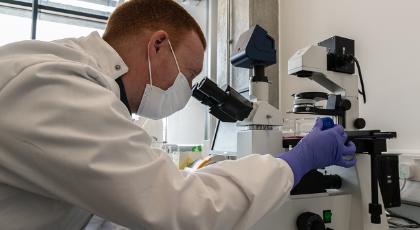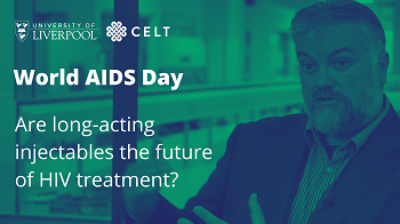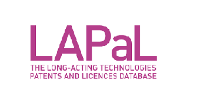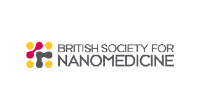Taking control of the HIV epidemic – How long-acting injectables can help reach ambitious targets

HIV continues to be a global public health concern with approximately 40 million people living with HIV infection in 2021 globally – the epidemic has sadly claimed millions of lives all over the world.
There is no cure, but in recent years better access to effective HIV prevention, diagnosis, treatment and care now means HIV infection is manageable, enabling those affected to lead long and healthy lives.
The WHO has set a target of ending the HIV epidemic by 2030. In order to achieve this target, significant investment is needed to scale-up and get back on track after COVID19-related disruptions slowed down recent progress.
PrEP-aring for Success
Pre-exposure Prophylaxis (PrEP) has emerged as a highly effective way to prevent HIV transmission. PrEP is a daily commitment, taken by people at risk of HIV infection to protect them from exposure. As long as the medicine is sustained in the bloodstream, the person is protected from HIV and the virus can be stopped from establishing infection throughout the body.
PrEP reduces the risk of getting HIV from sex by about 99%, and among people who inject drugs by at least 74% when taken as prescribed. Complications can arise when regimens aren’t adhered to as PrEP is much less effective when it is taken incorrectly.
Traditional oral PrEP requires chronic dosing which presents various complex issues. Taking daily regimens can be difficult because of drug-related side effects and toxicity, drug resistance if tablets are not taken as prescribed and other social issues such as stigma and complex mental health issues.
Recent innovations in long-acting injectable medicines now offers patients a much-needed alternative to oral PrEP. Hundreds of tablets can be replaced with injections that require administration far less frequently. Through this method of delivery, the drug is injected into the body where it is sustained over a period of months, as opposed to being eliminated over the course of a single day, and the drug is released slowly and sustained over a longer period of time, relieving the ongoing burden that daily tablets have on patients and reducing non-adherence and potentially drug resistance.
Two recent studies by the HIV Prevention Trials Network (Trial 084 and Trial 083 update report) suggest that long-acting injectable PrEP is more effective than oral regimens, underlining the important role long-acting injectables has on the WHO target.
Regulatory progress
Long-acting HIV therapy has gained substantial media coverage in recent years with a series of approvals from various drug regulation agencies. The first long-acting injectable treatment for HIV was approved in 2020 by the EMA for the European market. Later, in 2021, the first long-acting PrEP medicine was approved by the FDA in the USA. In November last year we saw a huge step forward in the UK as the first long-acting ART was approved for use in England and Wales.
These approvals demonstrated great progress for HIV as it meant, for those eligible, an intense chronic oral regimen of taking tablets daily could be replaced by just 6 injections per year, massively reducing issues around pill burden.
An important milestone for global health was met on July 28 2022 as the Medicines Patent Pool and ViiV healthcare announced a groundbreaking voluntary licence agreement enabling selected generic manufacturers to develop, manufacture and supply generic versions of long-acting HIV prevention in LMICs where the HIV burden is highest.
Professor Andrew Owen, co-Director of CELT said
The voluntary licencing of long-acting cabotegravir to the medicines patent pool is hugely significant and further lays the foundation for patients everywhere to benefit from these next generation medicines. Early licencing is imperative to ensure equity to medicines for HIV and other communicable and non-communicable diseases, and reduce the delays between availability in HIC and LMIC where the burden of disease is often higher
Our approach to long-acting HIV therapy
CELT scientists have a rich history in long-acting HIV research having committed ten years of research into the development of drugs that can be delivered by this approach.
When we started our journey, our mission was to widen the spectrum and expand global knowledge in HIV treatment and prevention through long-acting drug delivery to reduce the number new infections as well as improve the quality of life for people living with HIV.

In 2014 we began an exciting multi-disciplinary collaboration with Johns Hopkins University to accelerate the development of safe long-acting injectable therapy for people living with HIV.
This project was implemented to reduce the long-standing issue of pill burden associated with intensive daily oral therapies. This project involved reformulating commonly used drugs as long-acting medicines using state-of-the-art nanoformulation technology developed by CELT co-Director, Professor Steve Rannard.
The project aim was to enable people living with HIV to replace oral dosing with a single injection that could be administered once a month, removing the need to take daily tablets which patients found it difficult to adhere to.
More on this story can be found here.
Our collaboration with Johns Hopkins University received a further £2.2m to investigate the use of nanotechnology to improve the delivery of drugs to HIV patients through novel implantable technologies that can deliver drugs for weeks or months.
In 2015 CELT received significant funding from United States Agency for International Development (USAID) as part of a £39m consortium to help optimise drug therapies for HIV. CELT’s interdisciplinary nanomedicine collaboration provided a unique contribution to this project through our combined expertise in pharmacology and materials chemistry. Our cross-faculty approach to research and development was critical enable reformulation of certain poorly soluble HIV drugs into lower dose formulations and translate these to medicines for low-and middle-income countries.
More on this story can be found here.
In 2019 the EPSRC awarded University of Liverpool and Queen’s University Belfast £1m to examine the use of micro array patches (MAP) – a transdermal patch to simplify administration of long-acting drugs for treatment or prevention of HIV.
The research builds upon University of Liverpool formulation technology that was licenced to University of Liverpool spin out company Tandem Nano Ltd, to design and test a novel type of transdermal patch that has hundreds of tiny projections on its surface, called microneedles. Upon painless skin application, these microneedles will dissolve and leave behind nanoparticles of medicine for treatment or prevention of HIV. These nanoparticles will dissolve over weeks or months so that patients no longer have to adhere strictly to oral regimens.
More on this story can be found here.
Making an impact on a global scale
Ensuring our work has widespread impact we have developed partnerships with key global organisations, providing us with a platform to improve the lives of people globally. We have adopted a pathways for development that mean our innovations are cheaper and more accessible to the poorest nations. Through an ongoing partnership with Medicines Patent Pool (MPP), we have consistently granted voluntary license agreements to provide access to new innovations developed in CELT labs.
One particular UoL and MPP licence grants access to our patented Solid Drug Nanoparticle (SDN) technology for low- and middle-income countries. This was the first voluntary licence agreement that the MPP has signed with a university and one which reduced access barriers to life changing treatment for the worlds poorest nations.
University of Liverpool spin-out, Tandem Nano, was established to accelerate development of new drug formulations. Tandem’s technology provides partners with tailored nanoparticles of insoluble materials allowing drug development to be achieved faster and more cheaply than traditional approaches. Tandem Nano and MPP struck a licence agreement focused on the development of their proprietary long-acting therapeutic technologies. This agreement seeks to improve health equality in low-resource settings by providing a route to significantly relieve the financial burden of healthcare in affected communities.
In forging these critical partnerships and collaborations, our work is rooted in some of the most impactful interventions developed in recent years that have solved long standing healthcare issues around HIV and other infectious diseases.
Our mission is to be a major catalyst in the transformation of current drug delivery systems through leadership in long-acting therapeutics research, product development and fundamental understanding. Our commitment to bridging the gap in healthcare provision is stronger than ever and we will continue innovating to influence governments, policy makers, healthcare providers and patients to increase the world-wide acceptability and accessibility of long-acting therapeutics.
Related Content
 World AIDS Day: Are Long-acting Therapeutics the Future of HIV Treatment?
World AIDS Day: Are Long-acting Therapeutics the Future of HIV Treatment?
CELT Co-directors Professor Andrew Owen and Professor Steve Rannard talk about their pioneering work into long-acting therapeutics for the treatment of HIV, and how their collaboration across scientific disciplines has brought about amazing results.
Useful long-acting drug delivery resources
To find out more about ongoing long-acting research programmes you can browse the excellent resources available via the links below.



